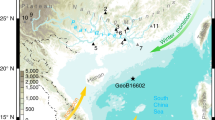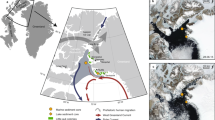Summary
Marion Island (47°S, 38°E) has one of the most oceanic climates on earth, with consistently low air temperatures, high precipitation, constantly high humidity, and low incident radiation. Since 1968 mean surface air temperature has increased significantly, by 0.025° C year−1. This was strongly associated with corresponding changes in sea surface temperature but only weakly, or not at all, with variations in radiation and precipitation. We suggest that changing sealevel (atmospheric and oceanic) circulation patterns in the region underlie all of these changes. Sub-Antarctic terrestrial ecosystems are characterized by being species-poor and having a simple trophic structure. Marion Island is no exception and a scenario is presented of the implications of climatic change for the structure and functioning of its ecosystem. Primary production on the island is high and consequently the vegetation has a large annual requirement for nutrients. There are no macroherbivores and even the insects play only a small role as herbivores, so most of the energy and nutrients incorporated in primary production go through a detritus, rather than grazing, cycle. Ameliorating temperatures and increasing CO2 levels are expected to increase productivity and nutrient demand even further. However, most of the plant communities occur on soils which have especially low available levels of nutrients and nutrient mineralization from organic reserves is the main bottleneck in nutrient cycling and primary production. Increasing temperatures will not significantly enhance microbially-mediated mineralization rates since soil microbiological processes on the island are strongly limited by waterlogging, rather than by temperature. The island supports large numbers of soil macro-arthropods, which are responsible for most of the nutrient release from peat and litter. The activities of these animals are strongly temperature dependent and increasing temperature will result in enhanced nutrient availability, allowing the potential for increased primary production due to elevated temperature and CO2 levels to be realized. However, housemice occur on the island and have an important influence on the ecosystem, mainly by feeding on soil invertebrates. The mouse population is strongly temperature-limited and appears to be increasing, possibly as a result of ameliorating temperatures. We suggest that an increasing mouse population, through enhanced predation pressure on soil invertebrates, will decrease overall rates of nutrient cycling and cause imbalances between primary production and decomposition. This, along with more direct effects of mice (e.g. granivory) has important implications for vegetation succession and ecosystem structure and functioning on the island. Some of these are already apparent from comparisons with nearby Prince Edward Island where mice do not occur. Other implications of climatic change for the island are presented which emphasize the very marked influences that invasive organisms have on ecosystem structure and functioning. We suggest that changing sealevel circulation patterns, by allowing opportunities for colonization by new biota, may have an even more important influence on terrestrial sub-Antarctic ecosystems than is suggested merely on the basis of associated changes in temperature or precipitation.
Similar content being viewed by others
References
Adamson DA, Whetton P, Selkirk PM (1988) An analysis of air temperature records for Macquarie Island: decadal warming, ENSO cooling and Southern Hemisphere circulation patterns. Pap Proc R Soc Tasm 122:107–112
Allison F, Keague PL (1986) Recent changes in the glaciers of Heard Island. Polar Record 23:255–271
Art HW, Marks PL (1971) A summary of biomass and net annual primary production in forest ecosystems of the world. In: Forest biomass studies, Sec. 25: Growth and yield. 15th Internat Union Res Organ Congr, pp 3–32
Bate GC, Smith VR (1983) Photosynthesis and respiration in the sub-Antarctic tussock grass Poa cookii. New Phytol 95:533–543
Berry RJ, Peters J, Van Aarde RJ (1978) Sub-Antarctic house mice: colonization, survival and selection. J Zool (Lond) 184:127–141
Bonner WN (1984) Introduced mammals. In: Laws RM (ed) Antarctic ecology, Vol 1. Academic Press, London, pp 237–278
Burger AE (1978) Terrestrial invertebrates: a food resource for birds at Marion island. S Afr J Antarct Res 8:87–99
Chown SL (1990) A physical model of insect colonization of islands in the sub-Antarctic. S Afr J Sci (in press)
Crafford JE (1990) The role of feral house mice in ecosystem functioning on Marion Island. In: Hempel G, Kerry KR (eds) Ecological change and the conservation of Antarctic ecosystems. Proc 5th SCAR Biology Symposium, Hobart 1988, Springer-Verlag, Heidelberg (in press)
Crafford JE, Chwon SL (1987) Plutella xylostella L. (Lepidoptera: Plutellidae) on Marion Island. J Entomol Soc South Afr 50:259–260
Crafford JE, Chown SL (1990) The introduction and establishment of the diamondback moth, Plutella xylostella, on Marion Island. In: Hempel G, Kerry KR (eds) Ecological change and the conservation of Antarctic ecosystems. Proc 5th SCAR Biology Symposium, Hobart 1988, Springer-Verlag, Heidelberg (in press)
Crafford JE, Scholtz CH (1987) Quantitative differences between the insect faunas of sub-Antarctic Marion and Prince Edward Islands: a result of human intervention? Biol Conserv 40:255–262
Crafford JE, Scholtz CH, Chown SL (1986) The insects of sub-Antarctic Marion and Prince Edward Islands; with a bibliography of entomology of the Kerguelen Biogeographical Province. S Afr J Antarct Res 16:42–84
Frei A, MacCracken MC, Hoffert MI (1988) Eustatic sea level and CO2. Northeast Environ Sci 7:91–96
French HM (ed) (1986) Impact of climatic change on the Canadian Arctic. Proceedings of the Canadian Climate Programme Workshop, Orillia, Ontario, March 3–5, 1986. Atmospheric Environment Service, Downsview, Ontario, pp 171
Gleeson JP, van Rensburg PJJ (1982) Feeding ecology of the house mouse Mus musculus Linnaeus, on Marion Island. S Afr J Antarct Res 12:34–39
Gremmen NJM (1981) The vegetation of the Subantarctic islands Marion and Prince Edward. Geobotany 3:149 pp
Hayward RJC (1983) Glacier fluctuations in South Georgia, 1883–1974. B Antarct Surv Bull 52:47–61
Hempel G, Kerry KR (eds) (1990) Ecological change and the conservation of Antarctic ecosystems. Proc 5th SCAR Biology Symposium, Hobart 1988, Springer-Verlag, Heidelberg (in press)
Hilbert DW, Prudhomme TI, Oechel WC (1987) Response of tussock tundra to elevated carbon dioxide regimes: analysis of ecosystem CO2 flux through nonlinear modelling. Oecologia 72:466–472
Huntley BJ (1971) Vegetation. In: Van Zinderen Bakker EM, Winterbottom JM, Dyer RA (eds) Marion and Prince Edward Islands. AA Balkema, Cape Town, pp 98–160
Jacka TH, Christou L, Cook BJ (1984) Data bank of mean monthly and annual surface temperatures for Antarctica, the southern ocean and South Pacific Ocean. ANARE Research Notes no. 22:1–97
Jaeger J (1988) Developing policies for responding to climatic change. WMO/TD no. 225. World Climatic Programme, Impact Studies, World Meterological Organization, Geneva, pp 53
Kira T, Ogawa H, Yoda K, Ogino K (1967) Comparative ecological studies on three main types of forest vegetation in Thailand IV. Dry matter production, with special reference to the Chong Rain forest. In: Kira T, Iwata K (eds) Nature and life in Southeast Asia vol. 5, Kyoto Fauna and Flora Research Society, pp 149–174
Lal M, Jain AK (1988) Climatic effect of observed changes in atmospheric trace gases at Antarctica. Atmospheric Environment 22:2047–2048
Lewis Smith RI (1990) Signy Island as a paradigm of biological and environmental change in Antarctic terrestrial ecosystems. In: Hempel G, Kerry KR (eds) Ecological change and the conservation of Antarctic ecosystems. Proc. 5th SCAR Biology Symposium, Hobart, 1988. Springer-Verlag, Heidelberg (in press)
Mendelsohn J (1981) Movements of prions Pachyptila spp and low pressure systems at Marion Island. In: Copper J (ed) Proceedings of the Symposium on birds of the sea and shore, 1979. African Seabird Group, Cape Town, pp 223–231
Miller PC (ed) (1981) Carbon balance in northern ecosystem and the potential effect of carbon dioxide induced climatic change. Carbon dioxide effects research and assessment programme workshop, San Diego, March 7–9, 1980. United States Department of Energy, Washington D. C. 20565, pp 109
Pammenter NW, Drennan PM, Smith VR (1986) Physiological and anatomical aspects of photosynthesis of two Agrostis species at a sub-antarctic island. New Phytol 102:143–160
Pittock AB, Salinger MJ (1982) Towards regional scenarios for a CO2-warmed earth. Climatic Change 4:23–40
Polar Research Board (1985) Glaciers, ice sheets and sea level: effects of a CO2-induced climatic change. US Dept. of Energy, Office of Energy Research Publication DOE/ER/60235-1, Washington DC, pp 348
Raper SCB, Wigley TML, Mayes PR, Jones PD, Salinger MJ (1984) Variations in surface air temperatures, Part 3: The Antarctic, 1957–82. Mon Wea Rev 112:1341–1353
Rosswall T, Heal OW (eds) (1975) Structure and function of tundra ecosystems. Ecol Bull 20, p 450
Rowe-Rowe DT, Green B, Crafford JE (1989) Estimated impact of feral house mice on sub-Antarctic invertebrates at Marion Island. Polar Biol 9:457–460
Sage RF, Sharkey TD, Seemann JR (1988) Acclimation of photo-synthesis to elevated CO2 in five C3 species. Plant Physiol 89: 590–596
SCAR (1989) The role of Antarctica in global change. Scientific priorities for the IGBP. ICSU Press, Miami, U. S. A., p 26
Schalke HJWE, Van Zinderen Bakker EM (1971) History of the vegetation. In: Van Zinderen Bakker EM, Winterbotton JM, Dyer RA (eds) Marion and Prince Edward Islands. AA Balkema, Cape Town, pp 89–97
Scott L, Van Zinderen Bakker (1985) Exotic pollen and long distance wind dispersal at a sub-Antarctic Island. Grana 24:45–54
Sims PL, Singh JS (1978) The structure and function of ten western North American grasslands. 3. Net primary production, turnover and efficiencies of energy capture and water use. J Ecol 66:573–597
Smith VR (1976) The effect of burrowing species of Procellariidae on the nutrient status of inland tussock grasslands on Marion Island. J S Afr Bot 42:265–272
Smith VR (1977) A qualitative description of energy flow and nutrient cycling in the Marion Island terrestrial ecosystem. Polar Rec 18:361–370
Smith VR (1987a) The environment and biota of Marion Island. S Afr J Sci 83:211–220
Smith VR (1987b) Production and nutrient dynamics of plant communities on a sub-Antarctic island. 2. Standing crop and primary production of fjaeldmark and fernbrakes. Polar Biol 7:125–144
Smith VR (1988) Production and nutrient dynamics of plant communities on a sub-Antarctic island. 5. Nutrient budgets and turnover times for mire-grasslands, fjaeldmark and fernbrakes. Polar Biol 8:255–269
Smith VR, French DD (1988) Patterns of variation in the climates, soils and vegetation of some subantarctic and antarctic islands. S Afr J Bot 54:35–46
Smith VR, Lewis Smith RI (1987) The biota and conservation status of sub-Antarctic islands. Environment International 13:95–104
Van Rensburg PJJ (1985) The feeding ecology of a decreasing feral house cat, Felis catus, population at Marion Island. In: Siegfried WR, Condy PR, Laws RM (eds) Antarctic nutrient cycles and food webs. Springer-Verlag, Berlin Heidelberg
Watkins BP, Cooper J (1986) Introduction, present status and control of alien species at the Prince Edward islands. S Afr J Antarct Res 16:86–94
Wielgolaski FE, Bliss LC, Svoboda J, Doyle G (1981) primary production of tundra. In: Bliss LC, Heal OW, Moore JJ (eds) Tundra ecosystem: a comparative analysis. International Biological Programme, vol 25. Cambridge University Press, Cambridge, pp 187–225
Williams AJ, Siegfried WR, Burger AE, Berruti A (1979) The Prince Edward Islands: a sanctuary for seabirds in the Southern Ocean. Biol Conserv 15: 59–71
Author information
Authors and Affiliations
Rights and permissions
About this article
Cite this article
Smith, V.R., Steenkamp, M. Climatic change and its ecological implications at a subantarctic island. Oecologia 85, 14–24 (1990). https://doi.org/10.1007/BF00317338
Received:
Accepted:
Issue Date:
DOI: https://doi.org/10.1007/BF00317338




